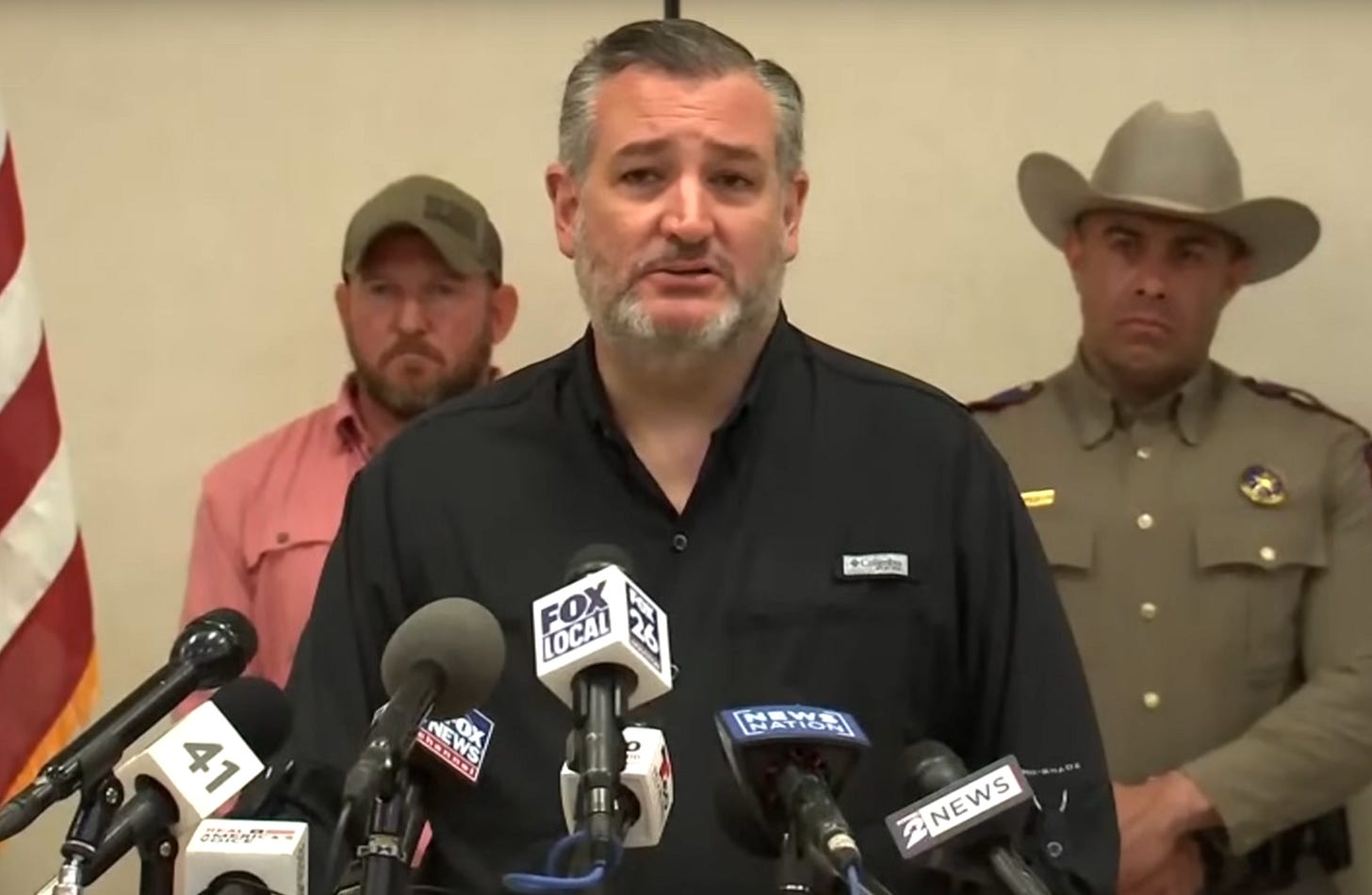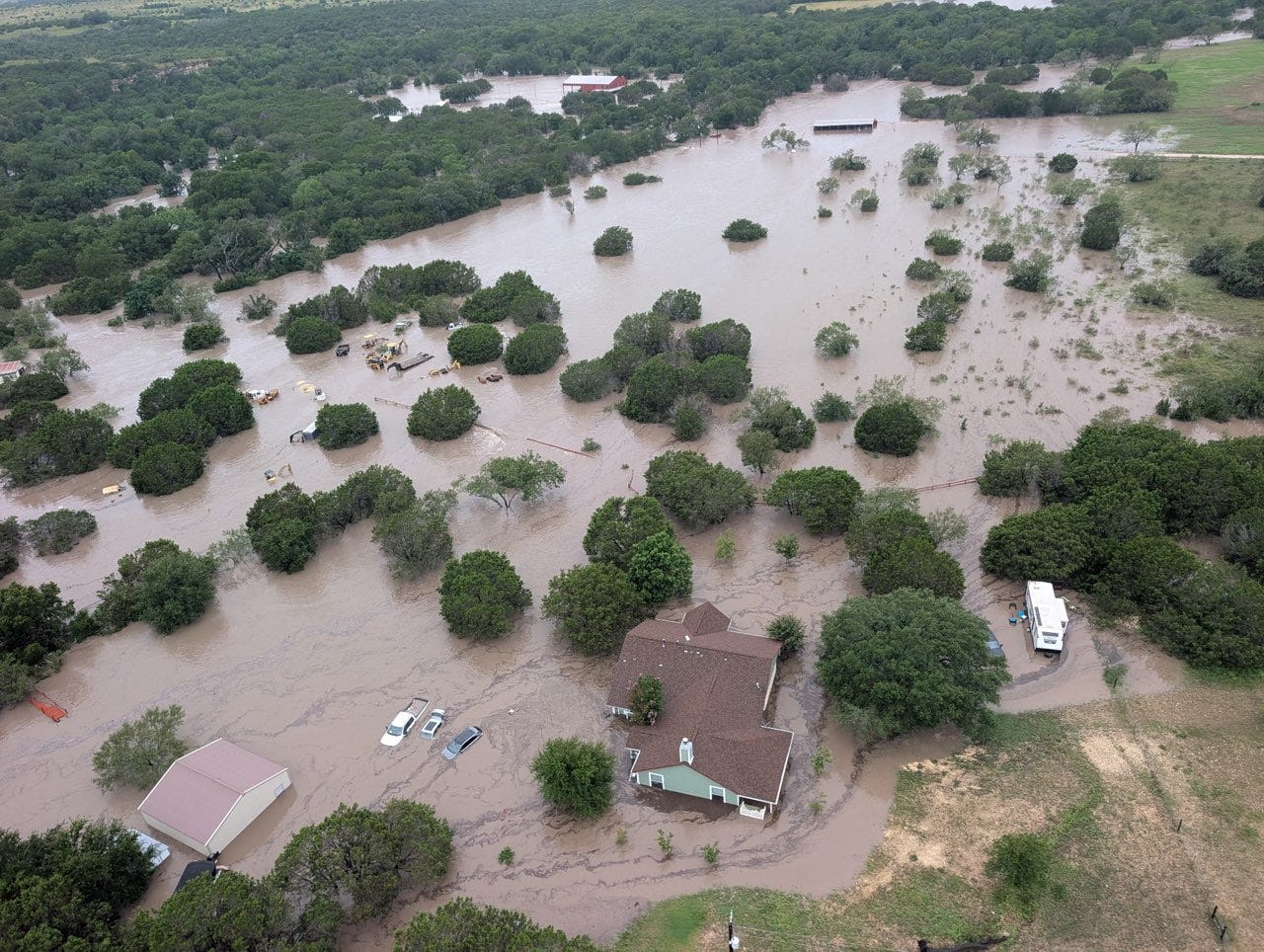The Texas Flood, Climate Change, and the Fossil Fuel Coverup
The news media routinely fail to point out what causes global warming and which elected officials are funded by the oil and gas industry

Rescue workers were still searching for bodies buried in twisted piles of brush and tree trunks along the Guadalupe River when Texas Sen. Ted Cruz stepped up to the microphones in Kerrville on July 7. “Texas is grieving right now. The pain, the shock of what’s happened these last few days has broken the heart of Texas,” he said, adding that he had just picked up his daughter at a nearby summer camp a week before.
Cruz’s press conference was one of the first public acknowledgements of the horrific devastation triggered by a record-setting flood that inundated an area of the central Texas Hill Country known as Flash Flood Alley. The rain-swollen Guadalupe River swept hundreds of campers, tourists and residents to their deaths in the early morning hours of July 4, including dozens of young girls attending Camp Mystic who were trapped in water that rose more than 20 feet in just a few hours.
There were few answers for how it could have happened. Cruz advised Hill Country residents to look to their churches to heal their wounds and rebuild, providing little solace for a shell-shocked community.
Cruz also warned that it was not the time to cast blame for the tragedy. “There will be those who blame President Trump,” he said. “After rebuilding, there will be a natural process to figure out what happened.”
Since the initial days of the disaster, “figuring out what happened” has focused mainly on emergency response efforts and flood warnings. But there has been little to no focus on what caused the Guadalupe River flood or other similar extreme weather events, which is something scientists figured out years ago. Warmer air from global warming holds more moisture, which causes more torrential downpours, worsens floods, and turbocharges hurricanes. And that global warming has been largely caused by burning coal, oil and gas, a fact that seems to get little mention these days.
It is no surprise that Cruz and other top elected officials from the Lone Star state would refrain from making that scientifically proven connection. After all, they are the recipients of millions of dollars in campaign contributions from the oil and gas industry and, in turn, have been blocking government action on climate change for decades. But it is a surprise that the news media, too, largely failed to adequately inform the public that the recent flood in Texas—as well as other extreme weather events—result from a climate crisis driven by human activity. That failure enables Cruz and other officials who benefit from the fossil fuel industry’s largesse, if they acknowledge that climate change is happening at all, to chalk it up to a natural phenomenon that we can’t do anything about.
Oil and gas industry’s point man in Congress
Cruz, a major supporter of President Trump’s “drill baby drill” energy policy, is currently the biggest recipient of oil and gas industry funds in Congress. In the 2024 election cycle, the Texas Republican raked in more than $1 million of the industry’s contributions, according to the nonpartisan group Open Secrets. That was nearly twice the amount received by the second-biggest oil and gas industry-funded senator, Republican John Barrasso of Wyoming. The 2024 election cycle was no anomaly. Since 1990, Cruz has been the second-largest recipient of oil and gas contributions in the Senate, pulling in more than $5.5 million. Only former Utah Sen. Mitt Romney received more.
Just a few weeks ago, Cruz backed provisions in the Senate version of Trump’s One Big Beautiful Bill Act that would cut energy credits for the booming wind and solar industry, despite the fact that Texas is the top state for wind energy production and the nation’s second-biggest solar power producer, which together account for 53,000 clean energy jobs. Cruz’s provisions, which were in the final version of the bill Trump signed into law on July 4, will likely raise energy costs and cripple clean energy projects.
As the oil and gas industry’s point man in Congress, Cruz is not above spreading outlandish falsehoods about environmental advocates who have been pressing state and federal officials to address the climate crisis. “We’re witnessing right now a systematic campaign against American energy,” Cruz asserted at a congressional hearing last month. “There is a coordinated assault by the radical left, backed and paid for by the Chinese Communist Party, to seize control of our courts and weaponize litigation against our energy producers.’’
The idea that the Chinese Communist Party is funding U.S. environmentalists to attack the U.S. fossil fuel industry is of course ludicrous. It is more likely that China, which is outpacing the United States in clean energy and electric vehicle innovation, would applaud Cruz’s efforts to hold U.S. clean energy back.
Certainly, Cruz is not the only politician in the pocket of the oil and gas industry in Texas, the nation’s top oil and gas producer. Gov. Greg Abbott also is paid handsomely by the industry, receiving more than $1 million in donations in the 2024 election cycle, according to Open Secrets, and that was just a drop in the oil barrel. A 2021 Associated Press (AP) investigation found that oil and gas industry donated more than $26 million to Abbott between 2015 and 2021.
“Oil and gas built and enriched Texas, and with that its politicians, including those who became president,” AP reported. “But none has reaped campaign contributions on the scale of Abbott, who in six years in office has raised more than $150 million from donors, more than any governor in U.S. history.” The sector that donated the most? Oil and gas.
In any case, the Texas Republican Party controls the offices of governor, secretary of state, attorney general, and both chambers of the state legislature, and its official platform minces no words. It proposes abolishing the U.S. Environmental Protection Agency, supports reclassifying carbon dioxide as a “non-pollutant,” and opposes what it calls “environmentalism, or ‘climate change’ initiatives that obstruct legitimate business interests and private property use.”
News media largely silent on the fossil fuel connection
Despite the overwhelming scientific consensus that burning fossil fuels is driving up global temperatures and wreaking havoc with the climate, mainstream news organizations all too often fail to point out the link between fossil fuel emissions and extreme weather disasters. Likewise, they fail to mention the financial ties elected officials have to the fossil fuel industry.

A case in point is the recent coverage of the Guadalupe River flood by The Washington Post, which has done award-winning reporting on the link between climate change and fossil fuel emissions in the past. This time, its reporters barely mentioned it. Since July 4, when the flood began, the paper has published at least 30 articles on the disaster and the growing problem of flooding. But it wasn’t until July 16 that the paper finally ran a story, on its front page, that mentioned the role fossil fuels play. Even then, however, it mentioned the link only in passing and buried it on the jump page in the twelfth paragraph. Moreover, the way the sentence is written is ambiguous. “Human-caused fossil fuel emissions and the greenhouse effect,” it reads, “have caused global temperatures to rise close to 1.5 degrees Celsius since the Industrial Revolution.” The sentence makes it seem as if “fossil fuel emissions” and “the greenhouse effect” are somehow two different things when they are directly related.
The Post’s blind spot on this key point is nothing new. The news media have long disregarded fossil fuel’s link to the climate crisis. For example, a 2019 study by researchers at the University of California, Berkeley, reviewed 600 New York Times articles from 1980 to 2018 and found virtually no mention of the basic facts of climate change, including its connection to fossil fuel emissions.
“We have this major problem: that people don’t seem to have a solid grasp of the fundamental ideas,” said study coauthor David Romps, a Berkeley professor of earth and planetary science. “And why would that be? There has been a well-funded campaign to spread misinformation and sow doubt about global warming, which has been very successful.…
“After you finish school, you learn about science primarily through the news,” he added. “And if you are not getting appropriate context from that news coverage, you are going to be confused.”
The Times has not improved much since the 2019 Berkeley study. Since July 4, the paper has published more than 70 Texas flood and flood-related articles and briefs. They all mention climate change, but only one article posted on the Times’ website on July 5 and “The Morning” newsletter emailed to subscribers on July 6 pointed out that fossil fuel emissions cause it.
Broadcast networks are equally at fault. A March investigation by Media Matters, a nonpartisan nonprofit that tracks mainstream press coverage, found that only 9 percent of the climate-related segments on broadcast news programs in 2024—28 out of 324—mentioned fossil fuels, slightly less than in 2023, when they cited it in just 12 percent of the segments.
The news media must do better
Journalists could easily make the fossil fuel connection in every climate-related story simply by stating something like: “Scientists say human-caused climate change is principally fueled by burning fossil fuels. Experts say not enough is being done to reduce fossil fuel use to avoid the worst consequences of global warming.” They also could easily mention where politicians get their money. That information is readily available online.
Pretty simple stuff. But most news organizations don’t take the time or space to report that information, leaving the public in the dark. If the news media don’t report the cause of the climate crisis, people will not get the information they need to protect themselves from the hazards of an increasingly dangerous world.
This month’s disaster in Texas’s Flash Flood Alley is just the latest of many examples of why it is critical for the news media to inform the public, not only about the cause of the climate crisis but also about the solutions for it. Likewise, reporters should hold elected officials accountable by reporting whose interests they represent. Given that we now have an administration that is doubling down on fossil fuels and kneecapping renewables, it is that much more imperative that the mainstream news media point out the facts about mounting climate threats. Otherwise, disasters like the recent one in Texas will happen again, with more campers washed away from their bunks in the middle of the night.
Rocky Kistner, Money Trail’s associate editor, previously worked as a reporter and producer at ABC News, the Center for Investigative Reporting, HuffPost, Marketplace and PBS Frontline.
Money Trail is a fiscally sponsored project of the Alternative Newsweekly Foundation, a 501(c)(3) public charity, EIN 30-0100369. Donations are tax-deductible to the extent allowed by law.





One reason the legacy news media avoid mentioning the fossil-fuel connection to climate change and its effect on weather? They make too much money off of oil companies via their advertorial departments. The Times has T Brand Studio and the Post has WP Brand Studio (now called WP Creative Group). These departments create ads that look like news articles, stage "thought leader" events, and otherwise burnish the public image of the corporations that hire them.
Yeah, yeah, there is supposed to be a "wall" between the editorial and business sides of these papers. But the very existence of the brand studios shows it doesn't exist.